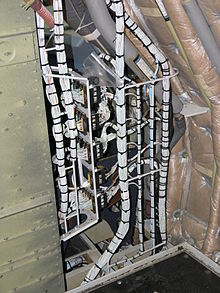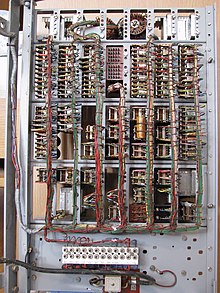Wiring harness


A cable harness is a bundling of individual cables , often pre-assembled, that transmit signals ( information ) or work flows ( energy ). The cables are routed as a cable harness and sheathed or held together by clamps, cable ties , twine or hoses.
production
The cables are combined into a cable harness according to the construction specifications on a special workbench or on a nail board ( shaped board ) and clamped together. This tree, which is only flexible to a limited extent, is then installed.
Cable harnesses are usually assembled according to the geometric and electrical requirements.
Despite advancing automation , wire harnesses are still being manufactured manually in the vehicle industry, and this will continue to be the case for the foreseeable future. This is largely due to the many different motion sequences involved, such as B.
- the threading of cables or strands into hoses or the threading of shrink tubing ,
- wrapping with fabric tape , especially at branches of cable strands,
- the attachment of contacts to the lines, especially with so-called double stops (two lines on one contact),
- the interlocking of hoses,
- Fixing strands with tape, clamps or cable ties.
Some of these motion sequences are difficult to automate (e.g. by robots ). Nevertheless, these activities can be learned quickly, even with low professional qualifications . This means that manual production is still more cost-effective than automation. With certain vehicles such as trucks, there is also a large number of variants (due to different configurations and vehicle lengths), which results in a very small batch size (up to 1). Nevertheless, different variants are made on the same shaped boards. Here in particular, humans still have an advantage over machines, as they can switch to different variants in a short time (without " reprogramming "). In order to reduce the number of variants, quantities of wiring harness variants can be grouped into stages ( step wiring harness ).
The prefabrication can be partially automated. This concerns u. a.
- the cutting of single lines (cutting machine),
- the striking of contacts on one or both sides of a line,
- partially equipping the connector housing with pre-contacted cables ( module ),
- the welding of several cable ends (automatic welding machine),
- the twisting of wires,
- bandaging of lines for insulation purposes
The test of the electrical function of a cable harness can be carried out with the help of a test table. The test bench is programmed beforehand with the data from the circuit diagram .
Economic benefit
Advantages of a cable harness compared to cabling with individual lines:
- The space required is optimized, less installation volume.
- Installation takes less time.
- The probability that components are connected incorrectly decreases.
- Maintenance is made easier.
- A wiring harness provides additional protection, e.g. B. against vibrations, abrasion and weather influences.
- By standardizing the process, cabling becomes more economical.
- The emission of interference ( electromagnetic compatibility (EMC)) can be reduced.
Cable harnesses in sound engineering
The cable harness commonly used in audio engineering (stage and studio) for the transmission of audio signals is also called multicore .
Cable harnesses / harnesses in network technology
In network cabling, harnesses are typically adapter cables that connect the existing 12 fibers to 6 duplex connectors such as a multi-fiber connector system such as the MPO connector . B. Split LC or SC connector.
See also
Specialist literature
- Robert Bosch (Ed.): Autoelectronics Autoelectronics . 5th completely revised and expanded edition. Vieweg & Sohn Verlag, Wiesbaden 2007, ISBN 978-3-528-23872-8 .
Web links
- Creating a Wire Harness Using Harness Design (accessed July 5, 2019)
- Automated production of cable harnesses by locally changing the bending stiffness (accessed on July 5, 2019)
- Tying the Wiring Harness (accessed July 5, 2019)